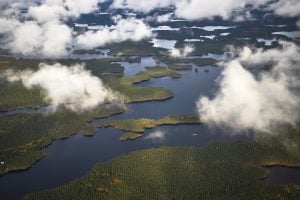
Places
The land holds memories
“All the mischiefs humans and the universe are capable of inflicting on an ecosystem have conspired to attack the prairies.”
- 6274 words
- 26 minutes
This article is over 5 years old and may contain outdated information.
Wildlife

James Hare calls it the contagious calling.
The University of Manitoba biology professor isn’t referring to his career, but to the behaviour of the black-tailed prairie dog. Earlier this year, Hare co-authored a paper that explains how the animal tests other prairie dogs’ vigilance when it performs its own version of “the wave” seen at sporting events, complete with a “wee-oo” sound. He explains his work below.
The first time I ever saw a prairie dog do this, I started laughing. It was amazing. I thought, Oh my God, they’re doing the wave! Then I started to wonder why. There was considerable speculation about the jump-yip. Was it a territorial call or an “all-clear” signal?
I was sitting at the local zoo once, watching black-tailed prairie dogs, and I noticed they used the jump-yip when predators were present. That made me think, If this is an all-clear signal and it’s not all-clear at all, what’s the actual function?
I started to brainstorm, and thought back to being a kid and hearing the test of the emergency broadcast system on television. I wondered if the prairie dogs were testing their own emergency broadcast system — whether others were cognizant of any potential threats in the environment.
The visual signal they give [when they sit upright and jerk their head back] backs up the acoustic signal, the “wee-oo” noise. They’re using the response of other individuals to gauge how aware those others are, then adjusting their own vigilance accordingly.
This kind of sociality evolves wherever there’s a pressure that would favour it. Prairie dogs face an incredible onslaught of predators (a colleague of mine calls them “the furry little cheeseburgers of the prairie) and extreme variation in weather, which are challenging circumstances.
I think we can learn an awful lot from this behaviour. It shows the value of mutual co-operation; that in a society, individuals have to, at times, put aside their own interest and behave in a way that is good for the group. It promotes greater success.
Are you passionate about Canadian geography?
You can support Canadian Geographic in 3 ways:

Places
“All the mischiefs humans and the universe are capable of inflicting on an ecosystem have conspired to attack the prairies.”

Wildlife
Salmon runs are failing and grizzlies seem to be on the move in the islands between mainland B.C. and northern Vancouver Island. What’s going on in the Broughton Archipelago?

People & Culture
Uprooted repeatedly by development projects, the Oujé-Bougoumou Cree wandered boreal Quebec for 70 years before finding a permanent home. For some, the journey continues.

People & Culture
The story of how a critically endangered Indigenous language can be saved